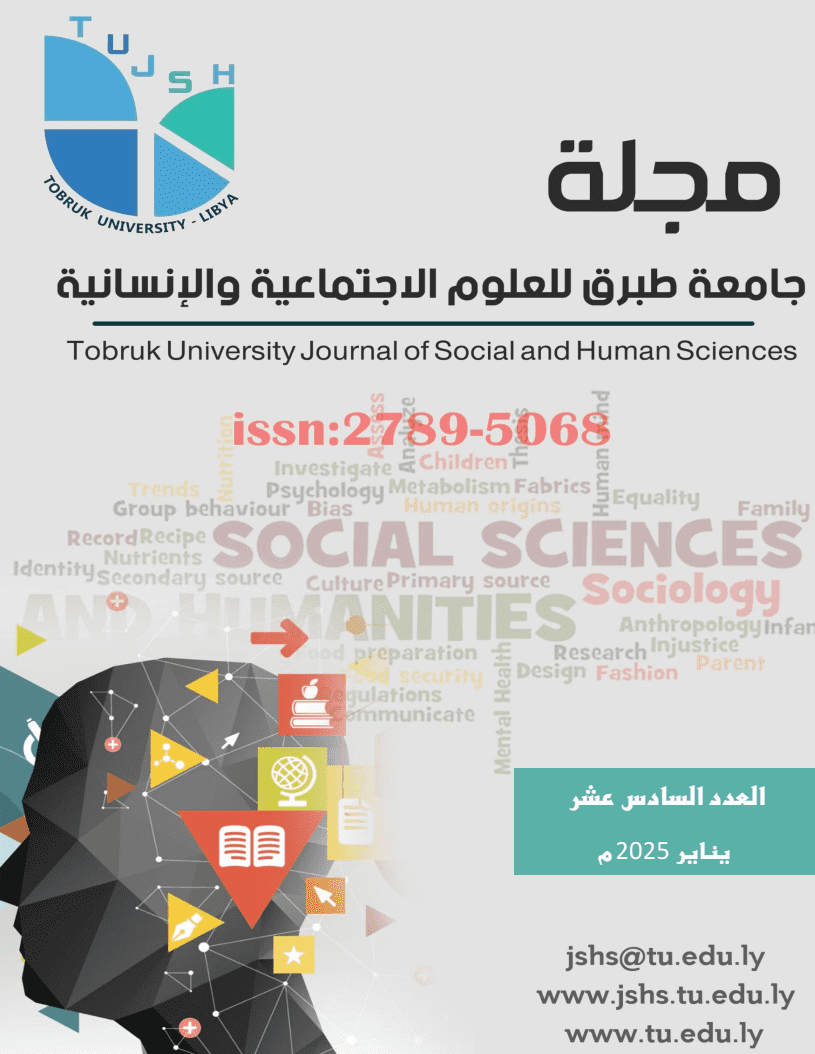Jaghbub Oasis in ancient times
DOI:
https://doi.org/10.64516/nk4xcy75Keywords:
Siwa, Wadi al-Nil, Libyan convoys, FezzanAbstract
The ease of communication between Libya and Egypt and the absence of natural obstacles separating them, gave geographical importance to the oasis of Jaghbub as a station linking the Libyan desert and the Nile Valley through the Siwa Oasis, so this site made it an effective impact in transferring the manifestations of civilization since ancient times. The Libyan man went to the Nile Valley without others through these oases when the climate changed and the era of drought began, so the oasis of Al-Jaghbub in those times was an environment with a great impact on communications and the exchange of religious and cultural beliefs, as the civilization that was transferred from the Libyan desert through these oases is an intellectual civilization, experiences and experiences, which contributed to enhancing cultural interaction with its geographical surroundings, which prompted the Libyan man carrying his beliefs, ideas and experiences to start his life on the banks of the Nile Valley with what he ended up with. From desert cultures.
During the historical era, the ancient Libyan man was able to transcend geographical and social distances through commercial contact with Egypt through the oasis of Al-Jaghbub, especially in the Pharaonic era, where the historian Herodotus mentioned desert routes for caravans through the oases, extending from the Nile Valley to the west, linking the Egyptian and Libyan oases and starting from Thebes in southern Egypt to the Libyan interiors, where the oasis of Awjila appears as if it were the millstone of a network of desert caravan routes, which helped - I believe - the man of the desert to reuse The ancient commercial caravan routes, starting from the oases of Fezzan to the Siwa oasis, passing through Al-Jaghbub, where many pharaonic tombs and mummies were found as a settlement site of importance in the trade routes with Siwa and then Thebes, and for this reason, the oasis of Al-Jaghbub is considered a mixture of objective and subjective elements in a historical, social and ideological reality integrated in diversity and understanding with the Egyptian oases, and within the framework of a historical territorial integrity accumulated with the Libyan oases throughout ancient historical times.
Hence, interest in studying and treating the history of Al-Jaghbub Oasis in ancient times has been active as one of the most important forms of civilizational interaction and its impact on neighboring cultures and civilizations.
Downloads
References
1) غوتي منال، سيلة سلاف، العصر الحجري الحديث في الجزائر، رسالة ماجستير غير منشورة ، كلية العلوم الإنسانية والاجتماعية قسم التاريخ، جامعة 8 ماي 1945،الجزائر، 2015-2016،
2) عبدالعزيز طريح شرف، جغرافية ليبيا، مركز الاسكندرية للكتاب، الإسكندرية، ط 3، 1996،
3) بن السعدي سليمان، علاقات مصر بالمغرب القديم منذ فجر التاريخ حتى القرن 7 ق.م، اطروحة دكتوراه غير منشورة، جامعة منتوري قسنطينة، الجزائر، 2008-2009،
4) لاروند، أندريه، في تاريخ ليبيا القديم (برقة في العصر الهيلينستي) من العهد الجمهوري حتى ولاية أغسطس، ترجمة محمد عبد الكريم الوافي، منشورات جامعة قار يونس، ط1، بنغازي. 2002،
5) سالم محمد عبدالله هويدي، الحضارة الجرمية-دراسة في عوامل النشؤ والازدهار والانهيار، منشورات المركز الوطني للمحفوظات والدراسات التاريخية، طرابلس، 2010،
6) محمد سليمان أيوب، جرمة من تاريخ الحضارة الليبية، دار المصراتي للطباعة والنشر، طرابلس،1969،
7) رجب عبدالحميد الأثرم، هيرودوتس والليبيون، مجلة البحوث التاريخية، طرابلس، منشورات مركز جهاد الليبيين للدراسات التاريخية ،ع 2، السنة الرابعة عشرة، 19
8 )i. Bovill, E.W., The Golden Trade of The Moors, London1968, PP. 18-22 (2)
9) فرنسوا شامو، في تاريخ ليبيا القديم- الإغريق في برقة-الأسطورة والتاريخ، ت.محمد عبدالكريم الوافي ، بنغازي ، منشورات جامعة قار يونس، ط1، 1990،
10) محمد مصطفى بازامة، تأثير الليبيين في الحضارتين المصرية واليونانية وتأثرهم بهما، ليبيا في التاريخ، المؤتمر التاريخي الذي نظمته الجامعة الليبية في الفترة من 16 الى 23 مارس 1968، منشورات الجامعة الليبية، بنغازي، 1968،
11) . Wainwright,G.A.,The Sky Religion in Egypt Cambridge,1938,p85 (2)
12) عبداللطيف محمود البرغوثي، التاريخ الليبي القديم من أقدم العصور حتى الفتح الإسلامي، ج1، منشورات تامغناست ،د.ت،
13) عبدالكريم فضيل الميار، قورينا وبرقة في العصر الروماني من 74 ق.م- 117 م، طرابلس، منشورات الشركة العامة للنشر والتوزيع والإعلان، ط1،1978، 13
14) رجب عبدالحميد الأثرم، محاضرات في تاريخ ليبيا القديم ،منشورات جامعة قاريونس، بنغازي، ط 2-3، 1998،
15) عبداللطيف محمود البرغوثي، التاريخ الليبي القديم من أقدم العصور حتى الفتح الإسلامي، ج1، بيروت ، دار صادر،
16) فيليب كنريك، قورينائية(إقليم المدن الخمس)،ت. أحمد بوزيان وعبدالله الرحيبي، مطبوعات جمعية الدراسات الليبية، تونس، 2013،
17) مقابلة شخصية أجراها الباحث الدكتور أحميده خيرالله الداره مع الراوي وهو المواطن الليبي السيد (الجبالي تركي مجيد سعد، قطعاني عيت يونس) من سكان مدينة طبرق ، حي الحرية، بتاريخ 10/8/2023م
18) ر.ج. جودتشايلد، دراسات ليبية، ت. عبدالحفيظ فضيل الميار، أحمد اليازوري، مركز جهاد الليبيين للدراسات التاريخية، طرابلس، 1999،
19) فيليب كنريك، قورينائية(إقليم المدن الخمس)،ت. أحمد بوزيان وعبدالله الرحيبي، مطبوعات جمعية الدراسات الليبية، تونس، 2013،
Downloads
Published
Issue
Section
License
Copyright (c) 2025 د.أحميدة خيرالله الداره مسعود (Autor/in)

This work is licensed under a Creative Commons Attribution 4.0 International License.








